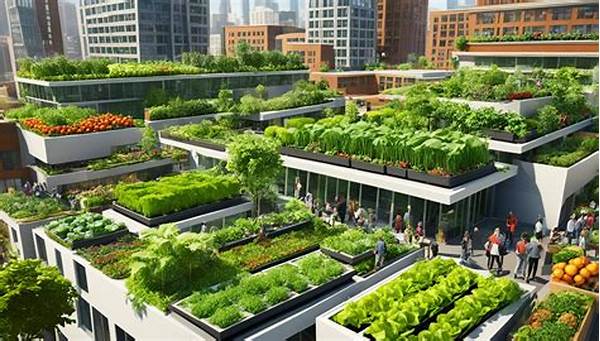Hey there, fellow green thumbs and city dwellers! Have you ever wandered around your cramped apartment, yearning for just a teensy bit of nature in your concrete jungle? Well, you’re not alone, and luckily, there’s a growing movement that’s bringing farms into urban spaces. Welcome to the world of efficient urban farming practices—a game-changer for those of us who dream of fresh produce but live in, let’s face it, tiny spaces. So, grab your shovel (or maybe just a trowel) and join me on this leafy adventure!
Read Now : “deal On Family Waterpark Admissions”
The Upside of Urban Farming
Urban farming is all the rage these days, and for good reason! Imagine having a bounty of fresh veggies right at your doorstep, even if you live on the fifth floor of an apartment building. These efficient urban farming practices allow us to capitalize on limited space, making the most out of rooftops, balconies, and any other tiny plots of land available. It’s about being smart with what we’ve got and turning concrete jungles into green havens.
But, it’s not just about food. These efficient urban farming practices help reduce our carbon footprint. By growing locally, we cut down on food miles—those long distances that trucks travel to bring us fresh produce. Plus, green spaces help filter urban air, a much-needed benefit in bustling cities plagued by pollution. And let’s not forget the mental health perks; having a slice of nature within reach can do wonders for the soul!
Finally, by embracing efficient urban farming practices, we can make a significant impact on food security. As urban populations swell, relying solely on traditional farming might not cut it. Urban farming introduces sustainable ways to boost food production, ensuring everyone has access to nutritious, locally-grown food. It sounds like a win-win to me!
Components of Urban Efficiency
1. Vertical Gardens: Maximizing space by growing plants upward in vibrant towers.
2. Hydroponics Systems: Growing veggies in water without soil, saving precious ground space.
3. Rooftop Gardens: Turning grey rooftops into lush green spaces for a constant veggie supply.
4. Smart Tech Integration: Using apps and sensors to monitor plant health and resource use.
5. Community Plots: Sharing spaces with neighbors to build efficient urban farming practices together.
Technology Meets Greenery
Incorporating technology into urban farming has taken efficient urban farming practices to the next level. Sensors and smart systems help track sunlight, moisture, and nutrients, ensuring every plant gets exactly what it needs. Think of it like a Fitbit, but for your plants! This efficient approach ensures nothing goes to waste, and every plant grows to its full potential—awesome for city farmers short on time and space.
Drones are also buzzing into the picture, helping to monitor large urban farms, snap photos, and analyze plant health. These high-tech gadgets make it easier than ever to keep our urban jungles thriving. And then there’s aquaponics—farming that combines aquatic life with hydroponics, creating a sustainable ecosystem where fish and plants coexist in harmony. These innovative systems are perfect for budding urban farmers who want to make an impact on sustainability.
Sustainable Practices with a Personal Touch
Efficiency in the Heart of the City
When it comes to efficient urban farming practices, individual efforts matter. Every balcony garden, rooftop plot, or community patch contributes to a larger movement. Efficient techniques ensure that city farming isn’t just possible but viable, supporting both people and the environment in harmony. City-dwellers are discovering that with a little creativity, anyone can partake in this green revolution.
Read Now : Eco-therapy And Mental Rejuvenation
Imagine unwinding after a day of work by tending to your garden, plucking fresh herbs for dinner, or just soaking up the sight of greenery. Efficient urban farming practices make this reality accessible and sustainable. They’re transforming fast-paced urban spaces into nurturing environments for plants and people, bringing a touch of tranquility and productivity even amidst skyscrapers and busy streets.
Planting the Seeds for Future Growth
Efficient urban farming practices aren’t a passing trend; they’re paving the way for future generations. With increasing urbanization, innovative farming solutions are becoming essential. By incorporating these practices today, we lay the groundwork for resilient cities capable of feeding future populations sustainably and healthily. Now, that’s some powerful planting—creating a legacy greener than any city park!
If you’re looking for a way to contribute to cleaner air and a more sustainable lifestyle, why not try your hand at efficient urban farming practices? You don’t need acres of land, just a patch of ambition and a little creativity. Before you know it, you’ll be a thriving part of this urban green movement, proving that where there’s a will, there’s a way.
Creating a Community of Green Enthusiasts
Urban farming isn’t just about growing plants; it’s about growing communities. By sharing efficient urban farming practices, urbanites can connect over shared passions, exchange knowledge, and cultivate friendships alongside fresh produce. It’s about creating supportive networks that enhance not only individual gardens but also bring people together for a common good.
Community gardens are blossoming across cities, transforming empty spaces into productive green havens. These social hubs offer fantastic opportunities to learn efficient urban farming practices from seasoned growers and foster a spirit of collaboration. As cities continue to expand, the importance of such initiatives grows, ensuring that urban environments remain hopeful and vibrant into the future.
Summing Up the Urban Harvest
In summary, efficient urban farming practices are reshaping the way we think about food production in cities. By using innovative techniques and technology, we’re able to make the most of small spaces and contribute positively to our environment. It’s a phenomenal blend of innovation and tradition, one that encourages us to rethink how food can be grown in bustling urban settings.
Whether you’re living in a tiny studio apartment or a spacious loft, efficient urban farming practices have something to offer. They bring a slice of nature to even the most cramped urban spaces, tapping into the potential for self-sufficiency and community connectivity. So, why not start a project of your own? Dive into the world of urban farming and witness firsthand the delightful transformation these practices can bring.
Through efficient urban farming practices, cities can morph into sustainable food production centers. It empowers individuals, communities, and cities to thrive together, fostering a future where urban living and agriculture harmoniously coexist. The journey to a greener tomorrow starts today, right from the comfort of our urban homes.



